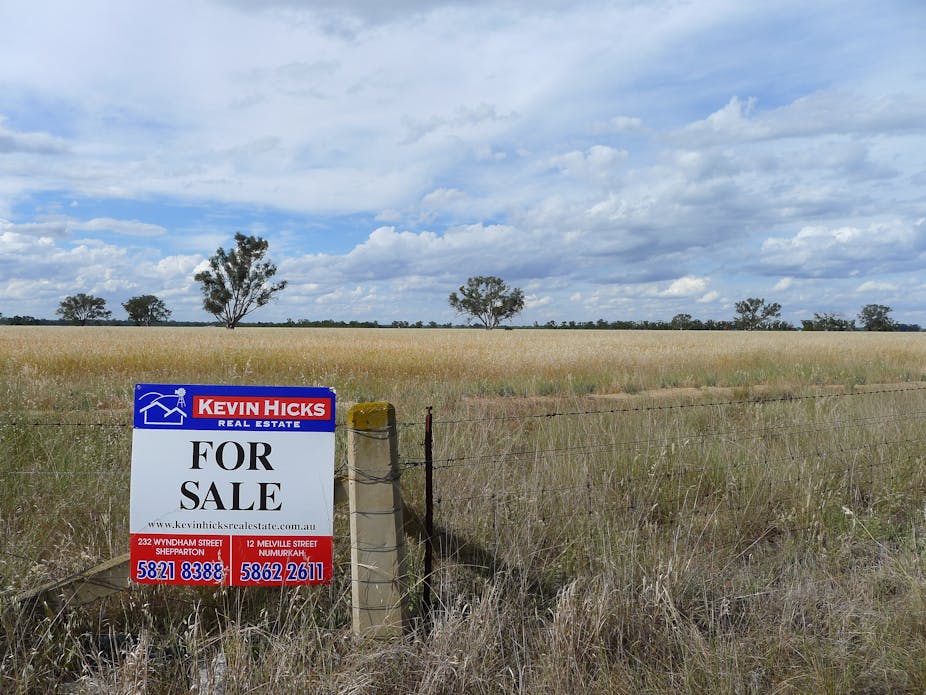The debate about who owns Australia’s farmland is often expressed in crude and narrow ways, and not just on talkback radio. Take last year’s leaders debate at Rooty Hill during the final week of the election campaign in which Kevin Rudd declared himself “old fashioned” on the issue of foreign access to Australian land.
The problem is the question of “farmland” has come to mean many different things to many different interest groups. It now exists as narrative shorthand for diverse moral panics about the future of food, the nation’s water resources, the environmental effects of coal seam gas, the political economy of foreign investment (especially from China), and the power of big agribusiness.
Dig into this debate, and what emerges is a sense of middle Australia fearing for the fortunes of “mum and dad” farmers.
Farm businesses are in decline, but land is important
Of course, there is more than a little bit of truth in such fears. As the number of farm businesses in Australia continues its century-long retreat, it is fair to ask whether the decline has reached a critical tipping point. Are some agricultural industries under threat because they no longer have the required numbers of farmers to sustain their futures?
Succession problems within families are a huge issue, with a study of the Corangamite watershed in Victoria indicating more than 50% of properties are likely to change hands within a decade. And the ‘Lock the Gate Alliance’ highlights the pressures on farming from an array of fronts. The question is where to start unpacking these diverse debates.
One of us (Erin Smith) pursued this during PhD research. When farmers in rural Victoria were asked about their attitudes to owning land, they talked at length about the vital role this asset played in their lives and livelihoods. This was in spite of the fact that for many farmers, leasing (rather than owning) farmland is a clear option that could potentially provide greater operational flexibility and free up capital.
Analysing farmer responses to these questions revealed the ownership of land represented a desire to manage risk and uncertainty in an increasingly unpredictable world. For these farmers, owning land was a safe haven in their business and domestic worlds.

Data problems abound
So if we conclude that land is vitally important for family-based farm establishments, it might logically follow that there would seem to be strong reasons for governments to monitor the ownership of agricultural land.
Surprisingly, Australia does not have readily assessable national data on this topic. In fact, it wasn’t until 2010 that a national longitudinal survey of foreign interests in land and water was implemented. This survey has been widely criticised for its limited scope and, consequently, the distorted picture the data provide about ownership. Robust data at a finer scale is what’s required if we are to better understand the issues.
The states have Constitutional powers over land, meaning each jurisdiction operates its own land titles registers and spatial information offices. Less than two decades ago, these systems were paper-based. As each state computerised their operations, they did so in different ways. These differences in data capture and presentation make it difficult to construct national perspectives on this vital issue.
The first effort to merge these systems and create national perspectives on rural land ownership was published in 2012. This study found that 16.8% of land in the agriculturally productive area of rural Australia changed hands between 2004 and 2008. This gave an annual “churn rate” of 4.25%.
Agricultural land in densely settled areas had a higher propensity to change ownership, and as the drought wore on in the eastern states during this period, the overall rate of change slowed. In the heartland grazing and cropping belts, rates of change were generally low and more than half of all buyers were existing landowners in the same shire, indicating the key role of local farm aggregation in rural restructuring.
The database behind these estimates provide records of the entities that have legal title over land at any one time, generating a vehicle for tracking individual owners at a national scale. But when this project concluded in 2012 the reins were not taken up elsewhere in the bureaucracy, and so its findings have not been updated.
Even on the hot-button issue of foreign ownership of agricultural land, bureaucratic will and political enthusiasm appear laggard. National farm lobby groups have complained that you can’t have a sensible discussion about this issue in the absence of reliable, comprehensive and up-to-date facts.
The ownership of agricultural land is an issue of vital consequence to Australia’s farm sector. Talk to farmers, as we have, and they quickly and cogently tell you about its importance. It is a black mark on national debate that this reality is not translated into public action. Informed national debate on these topics requires data sets that clearly document who owns agricultural land, and at what rate it is changing hands.

